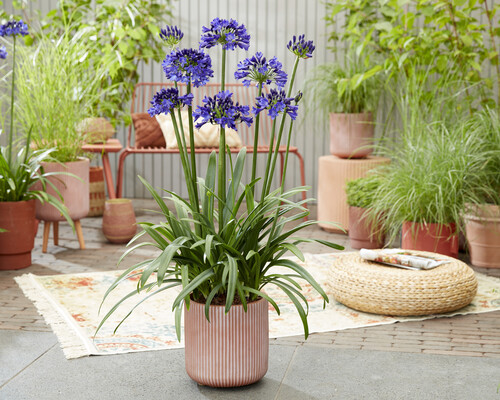Letting Loose the Secret to Successful Agapanthus Farming: Tips and Tricks for a Flourishing Garden
In the realm of gardening, growing agapanthus efficiently calls for a calculated strategy that includes numerous elements of plant care. By comprehending the subtleties of agapanthus cultivation, one can develop an environment where these plants prosper and flower generously.
Planting Agapanthus: Best Practices
When growing Agapanthus, appropriate soil preparation is vital for guaranteeing successful growth and development of these stunning blossoms. Agapanthus, commonly understood as Lily of the Nile or African lily, thrives in well-draining dirt with a somewhat acidic to neutral pH degree - Agapanthus. Before growing, it is vital to change heavy clay dirts with natural matter such as garden compost or peat moss to enhance drainage and supply necessary nutrients for the plants
To grow Agapanthus, choose a place that obtains complete sunshine to partial shade, as this will certainly promote healthy growth and abundant flowering. Dig an opening two times the diameter of the plant's root sphere and place the Agapanthus at the exact same deepness it was previously expanding. Gently backfill the hole with dirt, weighing down securely to remove any air pockets around the roots.
Water the recently grown Agapanthus thoroughly and continue to keep the dirt evenly damp, especially during the plant's active growing season. Agapanthus. Using a well balanced fertilizer once a month can further support the plant's growth and blooming. By following these ideal methods for planting Agapanthus, you can develop a stunning display screen of these fascinating blossoms in your garden
Perfect Soil Conditions for Agapanthus
For optimal growth and blooming success of Agapanthus plants, making certain the soil conditions are optimal is crucial. Agapanthus prospers in well-draining dirt with a slightly acidic to neutral pH level ranging from 6.0 to 7.0. This kind of dirt allows for ample water drainage, preventing waterlogging which can bring about root rot. To boost soil drain, think about adding organic matter such as compost or peat moss when preparing the growing website. Moreover, Agapanthus prefers dirt that is abundant in nutrients, so incorporating a balanced plant food throughout the growing period can promote healthy and balanced development and vivid blossoms.

Watering and Feeding Tips
To guarantee healthy development and lively blooms, appropriate watering and fertilizing methods are crucial for successful Agapanthus cultivation. Agapanthus plants take advantage of normal watering, particularly throughout the expanding season. It is suggested to water deeply once a week, guaranteeing the dirt is moist however not soaked. Throughout hot weather condition or in pots, more constant watering may be required to prevent the soil from drying out entirely.
When it concerns fertilizing Agapanthus, a well balanced plant food with equivalent components nitrogen, phosphorus, and potassium can be applied in the springtime to promote healthy development and blooming. Slow-release fertilizers are excellent for supplying nutrients gradually over a prolonged period. Stay clear of over-fertilizing, as this can result in excessive vegetation growth at the expenditure of blossoms.
In addition, including organic matter like garden compost into the soil can enhance nutrient levels and improve dirt structure, assisting in the overall health of the Agapanthus plants. By complying with these watering and feeding pointers, garden enthusiasts can guarantee their Agapanthus plants flourish and generate sensational displays of blossoms.
Trimming and Deadheading Methods
Appropriate trimming and deadheading strategies play an important duty in keeping the health and wellness and looks of Agapanthus plants, enhancing the important techniques of watering and feeding for effective growing. Pruning Agapanthus involves getting rid of invested blossom heads, yellowing or dead fallen leaves, and total shaping of visit here the plant to advertise better development. Deadheading, the procedure of removing discolored blossoms, not just boosts the plant's look but also encourages further growing.
When deadheading Agapanthus, it is advisable to trim off the blossom stem at the base making use of sharp, clean shears. This process reroutes the plant's power from seed manufacturing back right into origin and vegetation growth, promoting a much healthier and more durable plant. Normal deadheading can extend the flowering period of Agapanthus and prevent self-seeding, which can bring about overcrowding.
In regards to pruning, Agapanthus usually gain from a light trim after blooming to tidy up the plant and urge fresh growth. Cutting down the spent flower stems and removing any kind of broken or dead foliage helps keep the plant's vitality and total look. However, it is essential to prevent reducing right into the crown of the plant, as this can deteriorate its health.

Protecting Agapanthus From Vermins and Diseases
Applying reliable bug and illness monitoring methods is important to guarding the health my website and vigor of Agapanthus plants in cultivation. Agapanthus are normally durable plants, yet they can still succumb numerous bugs and conditions otherwise effectively looked after. One typical bug that influences Agapanthus is the Agapanthus borer, a caterpillar that tunnels right into the plant, triggering damages to the flowers and leaves. To avoid invasions, routine evaluation of the plants is crucial. If borers are discovered, they can be manually gotten rid of, or insecticidal soap can be used as a control step.
In addition to pests, Agapanthus are vulnerable to diseases such as origin rot and fungal leaf areas. By staying cautious and attending to bug and disease problems immediately, garden enthusiasts can aid their Agapanthus grow and grow.

Verdict
To conclude, successful growing of agapanthus needs correct growing strategies, optimal dirt conditions, ample watering and feeding, regular trimming and deadheading, and security from diseases and insects. By complying with these ideas and techniques, garden enthusiasts can make certain a prospering yard loaded with beautiful agapanthus blooms. Agapanthus. Remember to maintain consistent treatment and attention to information to promote the health and wellness this post and longevity of these sensational plants
When growing Agapanthus, appropriate dirt preparation is vital for guaranteeing successful growth and advancement of these gorgeous flowers.Water the freshly planted Agapanthus completely and proceed to keep the dirt evenly damp, especially during the plant's energetic expanding season.For optimal development and growing success of Agapanthus plants, making sure the soil conditions are ideal is critical. When planting or transplanting Agapanthus, guarantee the dirt is well-prepared to give the necessary structure for the plants to develop themselves successfully. One common parasite that impacts Agapanthus is the Agapanthus borer, a caterpillar that tunnels right into the plant, triggering damage to the flowers and fallen leaves.